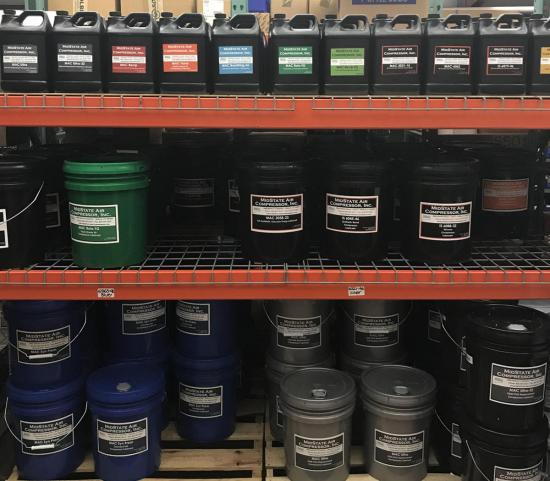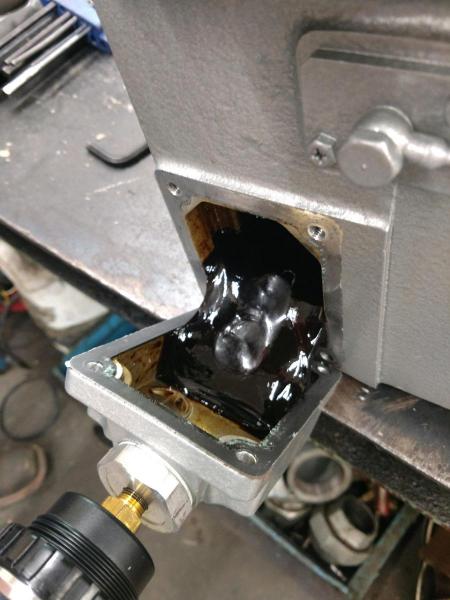Lubricants play a critical role in the safe, efficient, and a reliable operation of oil-flooded rotary screw air compressors. There are many factors to contemplate during the selection process, such as inlet air quality, temperature, and cost. One key factor often not given enough consideration is how the selected product will affect the maintenance cycle, and how these costs can be put into perspective. Presented here a review of available options, and how base stock selection can affect the maintenance of an air compressor.

Laboratory fluid analysis is highly recommended as part of an air compressor maintenance regiment.
Available Base Stocks
Modern air compressor lubricants are manufactured using a primary lubricant, and a mixture of additives. The lubricant itself, in its raw form is called a base stock, and once the additive package is mixed with this base stock the result is an air compressor lubricant. Base stocks used in air compressor lubricants are also used in all types of industrial and automotive applications, but air compressor fluid additives are designed specifically for use in air compressors.
There are a wide variety of base stocks available on the market. The most common types fielded in air compressors are:
- Synthetic hydrocarbons (PAO’s)
- Polyol Esters
- Polyglycols
- Blended Products
- Less common bases
These formulations represent the bulk of lubricants used in oil-flooded rotary screw air compressor applications. There are still some machines in industry running silicone-based lubricants or mineral oils, but these are rare.

Most full-service air compressor service companies keep an ample supply of lubricants in stock.
Synthetic Hydrocarbons (PAOs)
The Facts: This is the most common type of lubricant used in industrial applications – including air compressors – and automotive applications and is often referred to as synthetic hydrocarbons. PAOs are produced through the polymerization of linear alpha olefins which are derived from ethylene.
The Maintenance Advantage: PAOs are from the start, engineered to be extremely stable and provide very uniform flow for a wide temperature range. They also mix well with mineral oils and have a low volatility. Most finished air compressor products are rated for continuous operation at 175 oF to 200 oF for 8,000 hours.
Polyol Esters
The Facts: Polyol Esters (POEs) are the second most common type of base stock used in air compressors. These esters are formed by the process of esterification of a multifunctional alcohol with a carboxylic acid and are therefore not derived from crude.
The Maintenance Advantage: These fluids offer outstanding thermal stability, and have dispersant properties, keeping wetted parts extremely clean. When optimized for air compressor applications using additives, they can easily reach 10,000 or even 12,000 hours of continuous run time in standard conditions, giving the longest life of the group. POEs also dissolve and mix with additives and other base stocks extremely well, making them an ideal component in PAO-and PAG-based lubricants.
The Maintenance Disadvantage: One of this base stock’s biggest advantages is also one of its only drawbacks. POE-based lubricants are natural dispersants, which can be damaging to paints and finishes. They can also react with certain rubber or plastic sealing surfaces. Air compressors are for the most part manufactured with this in mind, so this may not be a deciding factor.
Polyglycols
The Facts: Derived from a propylene oxide, or some combination of propylene and ethylene oxide, Polyalkylene gylcols (PAGs), are another type of synthetic base stock. These lubricant base stocks became popular in the air compressor industry due to their inability to create varnish, a common side-effect of oxidized or thermally cracked lubricating oil.
The Maintenance Advantage: PAGs are the safest bet for keeping the inside of the machine clear of deposits and varnish. Most machines have clean wetted parts, even after tens of thousands of operating hours. They are very thermally stable and typically offer 8,000 to 10,000 hours of continuous service under standard conditions.
The Maintenance Disadvantage: Some PAGs are miscible with water and will create an oil water mixture that does not separate easily. This can be detrimental to bearing life due to decreased viscosity. Some PAGs don’t mix with PAO or mineral-based lubricants and can damage a system if mixed by mistake.
Air Compressor Lubrication & Maintenance - Webinar RecordingDownload the slides and watch the recording of the FREE webcast to learn:
|
Blended Products
The Facts: Virtually all air compressor lubricants, except for silicone fluids, are a blend of one or more base stocks plus additives. The type most seen with air compressor applications are a blend of PAO and mineral oil as addressed here.
The Maintenance Advantage: This is usually the most cost-effective option, as these products are a mixture of an expensive base stock, and a mineral oil then additized. As high-grade base stocks tend to be very expensive compared to basic hydrocarbons, a blended product often has significant cost savings. If there are environmental factors which require a frequent maintenance cycle, this type of lubricant is very attractive. For example, some applications require a very high service interval. This could be due to the placement of the air compressor in a very warm environment, or in an area where the inlet air is contaminated by particulate or chemicals that effect the lubricants ability to function normally. In these situations, these machines require additional maintenance to remain operational and therefore have a short duty cycle for the lubricant. As such, a user might choose to buy a less expensive 4,000-hour lubricant than run an 8,000-hour lubricant at a higher costs if the oil needs to be dumped after 2,000 hours. Depending on the base stock ratios and additives, these lubricants usually offer 4,000 to 6,000 continuous operating hours at standard conditions.
The Maintenance Disadvantage: A high percentage of mineral oil in the formulation will make the lubricant more susceptible to oxidation and thermal breakdown in over-heated applications. Adequate oil analysis is always recommended, but with this lubricant type, it’s more of a requirement. These lubricants will not have the same oxidative and thermal stability of some synthetic lubricants and can be more susceptible to failures based on inlet air quality.
Less Common Bases and Considerations
Less common base stocks are used in many machines around the world in application-specific functions, and at times, can be found in incorrect uses. Since they are far less common and are not normally used by most air compressor distributors, with exception to diesters for use with rotary vane air compressor applications.
Diesters: A close relative of the POE, diesters are derived from phthalic anhydride and alcohol. They are more common in rotary vane machines than in oil-flooded rotary screw air compressors. These fluids have great dispersant capability but are not typically recommended for oil-flooded rotary screw machines working in normal conditions as they can behave aggressively with certain types of sealing materials.
Silicone: Once a champion of air compressor lubricants, this fluid is virtually impervious to oxidation, and is the most expensive air compressor lubricant manufactured. This fluid has become less popular as it is extremely aggressive on sealing materials and cost prohibitive. This fluid is also extremely reactive with other base stocks, requiring caution when stored near other lubricant types to prevent cross contamination in the oil system.
Rust & Oxidation (R & O) Oil: Rust and Oxidation (R & O) oil is a very basic mineral derived lubricant popular in gearbox applications. They generally have very light additive packages and are not designed with high-speed rotating equipment in mind and are therefore very uncommon in oil-flooded rotary screw air compressors. Some R & O formulations are built for turbine applications, and have much more robust additive packages, but these lubricants are not commonly found in air compressor rooms. Machines using R & O fluids should be upgraded to an air compressor lubricant as soon as possible.
Hydraulic Fluid: Primarily designed to convey power in a hydraulic cylinder, this fluid is usually derived from a mineral base, and designed for film strength and corrosion control. Some formulations offer additional protection in thermal stability, low temperature fluidity, and high flash points, but none are formulated for optimized performance in an oil-flooded rotary screw air compressor environment. Like R & O fluid, machines running hydraulic fluid should be a maintenance priority.
Air Compressor Technology Monthly e-NewsletterWith a focus on Supply-Side Optimization, air compressor technologies and compressor control systems are profiled. System Assessment articles detail what compressor controls allow kWh consumption to match system demand. |
Additional Lubricant Considerations
There are a number of other important considerations that must be factored into lubricant selection.
- Oil analysis: Regardless of your choice in air compressor lubricant, a well-established oil analysis program is the key to successfully optimizing the performance of your lubricant. A PAG’s inability to varnish prevents visual evidence that something wrong is happening, for example, so the only way to determine the health of the lubricant is through oil analysis. Most oil failures can be prevented with proper analysis, making this the most important tool in the lubricant arsenal.
- Operating environment: It is always important to remember the air surrounding the air compressor is the same gas your air compressor is working to compress. Air that is extremely dirty, contaminated with particles, or chemicals ingested by the air compressor’s inlet will naturally have an effect when it encounters the lubricant.
Extremely wet conditions, or high humidity is not an ideal environment for a PAG. The possibility of natural gas fumes in the inlet air, will create issues with a POE. These are just two examples of how the inlet air quality should play an important role in your selection. Another common situation is poor quality (dirty) inlet air, that requires the fluid to be serviced at frequent intervals. In this environment, a blended product is the best choice. Always take inlet air quality into account before committing to a formulation.
- Manufacturers recommendation: Most air compressor manufacturers offer lubricant as part of their parts portfolio, and consulting the operating manual is always a good idea. These recommendations are normally based on standard operating conditions, so it may be wise to consider the application as well as the operating environment.

The importance of using the right lubricant based on the application cannot be understated to ensure efficient air compressor operation – while also avoiding problems. An example is using a fluid for an application that is beyond the fluid’s thermal rating, which can cause it to solidify as shown.
Meet the Needs of the Application and Environment
Environmental factors, applications, and the desired maintenance intervals themselves, are all deciding factors when choosing the appropriate air compressor lubricant. All lubricant types have advantages and drawbacks. This leaves the maintenance professional or operations manager the responsibility to choose what is best based on the application and environment. Those in the oil Industry or maintenance profession have a responsibility to recommend the right lubricant for the job, which is the very reason all these options are readily available. When a technician factors in the air quality, humidity, inlet temperature, and desired operating hours between service intervals, the right lubricant for the task can be identified.
About the Author
Dave Brockett of Isel Inc. is an Air Compressor Product Manager with over 20 years in the air compressor business, starting as an air compressor technician following military service. His experience includes project management, product development, maintenance management, and industrial equipment sales.
About Isel Inc.
Isel Inc. has provided custom blended air compressor lubricants around the world for over 25 years. Known throughout the industry as an extremely flexible, customer support-based manufacturer, Isel uses cutting edge chemistry and revolutionary manufacturing techniques to deliver lubricants of unmatched quality and durability. Isel is committed to providing air compressor manufacturers as well as service companies with the most advanced products available. For more information, visit https://iselinc.com/.
All photos courtesy of Isel Inc.
To read more Air Compressor Technology articles, please visit www.airbestpractices.com/technology/air-compressors.




